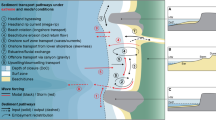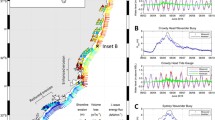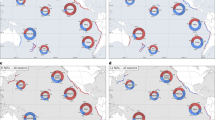Abstract
The Gold Coast sandy beaches of Queensland (Australia) are exposed to energetic wave conditions. Storms, particularly tropical cyclones, have a high potential of destruction. The Gold Coast has not experienced excessive erosive events over the past 30 years. However, some climate indicators suggest that cyclone frequency is likely to increase in response to global climate change within the near future. Over a 2-month period in early 2006, beach surveys were undertaken with a theodolite total station at four different sites. Offshore wave conditions were provided by SWAN regional wave modelling. During this study, the Gold Coast was exposed to three major storms, the first one being the second most energetic over the past 30 years. Results show a substantial variability of the beach response to these events along the Gold Coast, and that engineering structures do not have marked effects. Easterly swells have the greatest impact on the Gold Coast sub-aerial beach morphology. When low wave-energy conditions prevail, the southern Gold Coast beaches recover more quickly than the northern ones, as they are sheltered from high SE waves and draw advantage from the artificial sand bypassing system. Nevertheless, the data show that the Gold Coast beaches are exceedingly fragile. For instance, the early March decadal event considerably weakened the beaches, which resulted in surprisingly high erosion rates all along the Gold Coast during the two following annual wave events. This study suggests that the Gold Coast beaches would not be able to withstand the impact of an increased frequency of extreme events similar in scale to those of 1967.





Similar content being viewed by others
References
Allen M, Callaghan J (1999) Extreme wave conditions for the South Queensland coastal region. EPA Queensland Rep
Battjes JA, Janssen JPFM (1978) Energy loss and set-up due to breaking of random waves. In: Proc 16th Int Conf Coastal Engineering, Hamburg, ASCE, pp 569–587
Battjes JA, Stive MJF (1985) Calibration and verification of a dissipation model for random breaking waves. J Geophys Res 90(C5):9159–9167
Boak E, Turner I (2005) Shoreline definition and detection: a review. J Coast Res 21(4):688–703
Booij N, Ris R, Holthuijsen L (1999) A third-generation wave model for coastal regions. Part I. Model description and validation. J Geophys Res 104(C4):7649–7666
Browne M, Strauss D, Castelle B, Blumenstein M, Tomlinson RB, Lane C (2006) Empirical estimation of nearshore waves from a global deep-water wave model. IEEE Geosci Remote Sensing Lett 3(4):462–466
Browne M, Castelle B, Strauss D, Tomlinson RB, Blumenstein M, Lane C (2007) Near-shore estimation from a global wind-wave model: spectral processes, linear, and artificial neural network models. Coast Eng 54(5):445–460
Castelle B, Bourget J, Molnar N, Strauss D, Deschamps S, Tomlinson RB (2007a) Dynamics of a wave-dominated tidal inlet and influence on adjacent beaches, Currumbin Creek, Gold Coast, Australia. Coast Eng 54(1):77–90
Castelle B, Turner IL, Ruessink BG, Tomlinson RB (2007b) Impact of storms on beach erosion: Broadbeach (Gold Coast, Australia). J Coast Res (in press)
Dail HJ, Merrifield MA, Bevis M (2000) Steep morphology changes due to energetic wave forcing. Mar Geol 162:443–458
DHL (1970) Gold Coast, Queensland, Australia—Coastal erosion and relative problems. Delft Hydraulics Laboratory, The Netherlands, Rep R257
Dyson A, Victory S, Connor T (2001) Sand bypassing the Tweed River entrance: an overview. In: Proc Coasts & Ports 2001 Conf, 25–28 September 2001, Gold Coast, Queensland, Australia, pp 310–315
Hobbs J, Lawson S (1982) The tropical cyclone threat to the Queensland Gold Coast. J Geophys Res 2:207–219
Jackson LA, Tomlinson R, D’Agata M (2001) Combining surfing and coastal protection, what is the perfect surf? In: Proc Coasts & Ports 2001 Conf, 25–28 September 2001, Gold Coast, Queensland, Australia, pp 134–139
McGrath BL (1967) Erosion of Gold Coast beaches. J Int Eng Aust 40:155–166
Regnauld H, Pirazzoli PA, Morvan G, Ruz M (2004) Impacts of storms and evolution of the coastline in western France. Mar Geol 210:325–337
Ris R, Booij N, Holthuijsen L (1999) A third-generation wave model for coastal regions. Part II. Verification. J Geophys Res 104(C4):7667–7681
Short AD, Aagaard T (1993) Single and multi-bar beach change models. J Coast Res SI(15):141–157
Tolman HL (1991) A third-generation model for wind waves on slowly varying, unsteady and inhomogeneous depths and currents. J Phys Oceanogr 21:782–797
Turner IL (2006) Discriminating modes of shoreline response to offshore-detached structures. J Waterway Port Coast Ocean Eng 132(3):180–191
Turner IL, Aarninkhof SGJ, Holman RA (2006) Coastal imaging applications and research in Australia. J Coast Res 22(1):37–48
Wright LD, Short AD (1984) Morphodynamic variability of surf zones and beaches: a synthesis. Mar Geol 56:93–118
Acknowledgement
The research presented in this paper was performed within the framework of the development of a Gold Coast Shoreline Management Plan (GCSMP) on behalf of the Gold Coast City Council (GCCC). The authors wish to thank Gilles Sennes, Sophie Deschamps, Arnaud Feltz, Guillaume Marty, Stephane Armand and Renan Pointeau for their help during field measurements. The authors are grateful to Andrew Keally, from the Gold Coast City Council survey team, for providing the base station coordinates. The manuscript benefited from the constructive comments of two anonymous reviewers and the Geo-Marine Letters editorial team.
Author information
Authors and Affiliations
Corresponding author
Rights and permissions
About this article
Cite this article
Castelle, B., Le Corre, Y. & Tomlinson, R. Can the gold coast beaches withstand extreme events?. Geo-Mar Lett 28, 23–30 (2008). https://doi.org/10.1007/s00367-007-0086-y
Received:
Accepted:
Published:
Issue Date:
DOI: https://doi.org/10.1007/s00367-007-0086-y




